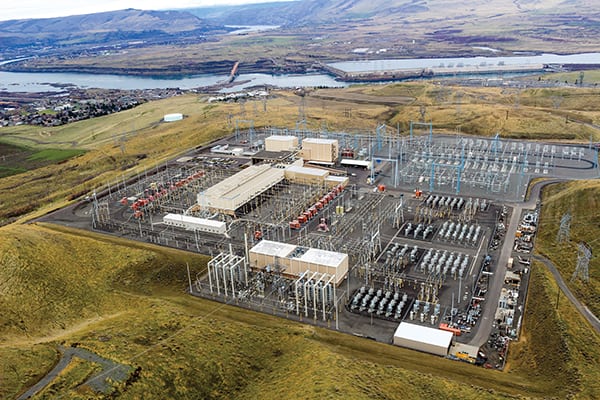Readying for New HVDC Line, U.S. Lags Behind Rest of World
The U.S. may be getting its first overhead 600-kV high-voltage direct-current (HVDC) line in more than 20 years. Developers are advancing the Plains and Eastern Clean Line, a 720-mile (1,150-kilometer [km]) project that could deliver 4 GW of renewable power from the Oklahoma Panhandle region to states in the Southeast. The project is spearheaded by Clean Line Energy and GE Energy Connections, though the U.S. Energy Department is also a participant. Construction on the line could begin in the second half of 2017.
The project is a big deal in the U.S., which has 20 HVDC transmission facilities, because it would be its most advanced. The nation’s most lauded HVDC project is the 500-kV Pacific DC Intertie, which has been in operation for over 30 years (Figure 4).
HVDC is a system that interconnects two alternating-current (AC) networks, converting AC voltage to DC voltage and vice versa. Ultra-HVDC (UHVDC) lines can operate at voltages of up to 800 kV, enabling bulk transport of power over longer distances. One much-emphasized benefit is that HVDC systems have lower losses than AC systems, which makes them more economical. In addition, the use of insulated cables along with HVDC in submarine and underground applications allows more power to be transmitted across long water crossings.
According to GE, the need for HVDC lines is becoming increasingly prominent globally as the utility environment becomes more complex. Utilities are managing new challenges such as increasing demand for electricity, connection of remote generation, growth of distant offshore wind, integration of variable renewable generation, the need for security of supply, increasing costs for land, and permits for new right-of-way access, which are increasingly difficult to obtain.
Yet the U.S. lags far behind a number of countries in installations, if operating voltage and capacity are compared. China leads the world’s efforts in advanced HVDC installations. Sixty years ago, ABB pioneered the technology in the world’s first commercial HVDC link, a 150-kV line that today transmits 320 MW at a distance of nearly 100 km—from Västervik, on the east coast of mainland Sweden to Ygne on the island of Gotland. In 2010, State Grid Corp. of China commissioned the world’s first 800-kV UHVDC line to export hydropower from the Xiangjiaba Dam in Sichuan province to Shanghai, 1,980 km away. Later that year, Siemens helped put up another 800-kV UHVDC line connecting Yunnan and Guangdong over 1,418 km. At least three other 800-kV UHVDC lines have since been commissioned in China: the Jinping-Sunan line (2013), the Nuozhadu-Guangdong line (2013), and the Xiluodu-West Zhejiang line (2014). Two UHVDC lines of 800 kV, the Northeast Agra line and the Champa-Kurukshetra, are also under construction in India, slated for completion in 2017. This September, Brazil and Uruguay commissioned a 500-kV, 420-km interconnection transmission line linking Brazil’s Candiota substation to Uruguay’s Melo substation.
Last June, meanwhile, ABB won orders to supply breakthrough technologies for the world’s first 1,100-kV line, the Changji-Guquan UHVDC link, which will transmit up to 12 GW of power from the Xinjiang region in the northwest to Anhui province in eastern China. ABB noted that the line offers a 50% increase in transmission capacity compared to the 800-kV UHVDC lines currently in operation, along with extending the transmission distance from 2,000 km to more than 3,000 km.
—Sonal Patel, associate editor (@POWERmagazine, @sonalcpatel)
